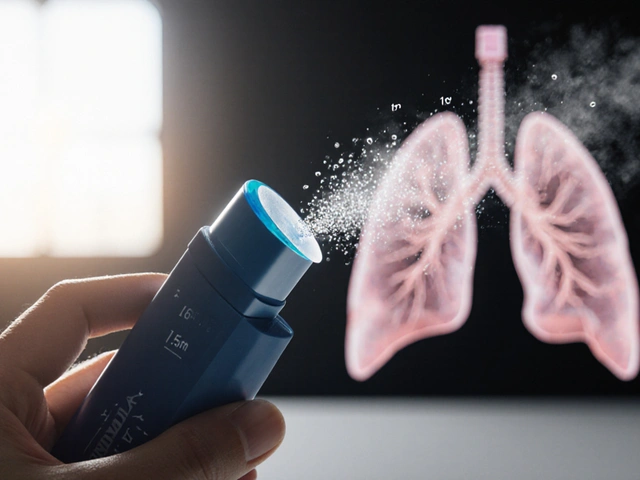Estrogen Therapy Selector
Your Symptoms
Medical History
Preference
When treating menopause symptoms, Conjubrook is a brand of conjugated estrogens derived from horse urine, approved for hormone replacement therapy. It’s often prescribed to relieve hot flashes, night sweats, and vaginal dryness. But the market now offers many alternatives that promise a more “natural” feel, fewer side‑effects, or better symptom control. This guide compares Conjubrook with the most common estrogen options, helping you decide which route fits your lifestyle and health goals.
TL;DR
- Conjubrook provides consistent dosing but can increase clotting risk.
- Estradiol (oral or transdermal) is bioidentical and usually safer for heart health.
- Estriol is weaker, good for mild symptoms and vaginal health.
- BHRT (compounded bioidenticals) offers custom dosing but lacks FDA oversight.
- Phytoestrogens and SERMs work differently; they’re not true hormone replacements.
How Conjubrook Works
Conjubrook contains a mixture of estrogenic compounds-mostly estrone sulfate, along with small amounts of estradiol and estriol. Once ingested, the liver converts estrone to estradiol, the most potent estrogen in the body. This cascade restores circulating estrogen levels, easing vasomotor symptoms and maintaining the uterine lining. Because the formulation is not a single molecule, the pharmacokinetics are broader, which can be a plus for some patients but also makes it harder to predict individual response.
Key Criteria for Comparing Estrogen Therapies
Before diving into each alternative, keep these factors in mind:
- Route of administration: oral pills, patches, gels, creams, or vaginal rings each affect absorption and risk profiles.
- Bioidentical vs. non‑bioidentical: Bioidentical molecules (estradiol, estriol) match the body’s natural hormones, while conjugated estrogens mix animal‑derived compounds.
- Safety outcomes: thrombosis, stroke, breast cancer, and cardiovascular disease rates differ by formulation.
- Symptom coverage: Some options excel at vasomotor relief; others focus on vaginal atrophy.
- Regulatory status: FDA‑approved drugs have rigorous testing; custom compounding may not.
- Cost and accessibility: Insurance coverage, pharmacy pricing, and out‑of‑pocket costs vary widely.
Alternative 1: Oral Estradiol
Estradiol is a bioidentical form of estrogen that mimics the hormone produced by the ovaries. Available as tablets (e.g., Estrace) or capsules, it delivers a single, pure molecule, allowing precise dose adjustments. Studies show transdermal estradiol reduces clotting risk compared with conjugated estrogens, making it a popular first‑line choice.
Typical dose: 0.5-2mg daily. Advantages include lower cardiovascular risk and a more natural hormone profile. Drawbacks may involve liver metabolism (for oral) and the need for regular monitoring of blood levels.
Alternative 2: Transdermal Estradiol Patch
The patch delivers estradiol through the skin, bypassing the liver’s first‑pass effect. This route results in steadier blood concentrations, fewer gastrointestinal side‑effects, and the lowest reported risk of deep‑vein thrombosis among estrogen therapies.
Typical dose: 0.025-0.1mg/day, changed twice weekly. It’s ideal for women with liver concerns or those who dislike taking pills.
Alternative 3: Estriol‑Based Products
Estriol is a weak estrogen often used in low‑dose vaginal creams or tablets. Because its potency is roughly one‑tenth that of estradiol, it mainly targets vaginal atrophy and mild hot flashes without significantly stimulating breast tissue.
Typical dose: 0.5-1mg daily (oral) or 0.5g vaginal cream three times weekly. It’s considered safe for short‑term use, but evidence for long‑term cardiovascular protection is limited.

Alternative 4: Bioidentical Hormone Replacement Therapy (BHRT)
Bioidentical Hormone Replacement Therapy (BHRT) refers to custom‑compounded mixtures of estradiol, estriol, progesterone, and sometimes testosterone, tailored to a patient’s hormone panel.
Pros: personalized dosing, ability to fine‑tune ratios, and often marketed as “natural.” Cons: lack of FDA approval, variable quality control, and insurance typically does not cover compounding fees. Clinical data are mixed, so many physicians prefer FDA‑approved options unless a patient has a clear need for customization.
Alternative 5: Selective Estrogen Receptor Modulators (SERMs)
SERMs like raloxifene act on estrogen receptors in bone and breast but block them in uterine tissue. They’re not true hormone replacement but can alleviate hot flashes and improve bone density.
Typical dose: 60mg daily. Benefits include reduced breast‑cancer risk, but side‑effects may include leg cramps and an increased risk of venous thromboembolism, similar to conjugated estrogens.
Alternative 6: Phytoestrogens (Soy Isoflavones)
Phytoestrogens are plant‑derived compounds that weakly bind estrogen receptors. Common sources include soy, red clover, and flaxseed. While they can modestly lessen mild menopausal symptoms, their effect is far weaker than prescription hormones.
Typical dose: 30-60mg isoflavone extract daily. They’re over‑the‑counter, inexpensive, and have a good safety profile, but they’re insufficient for severe vasomotor symptoms.
Side‑by‑Side Comparison Table
| Alternative | Formulation | Typical Dose | Key Advantages | Main Disadvantages | Regulatory Status |
|---|---|---|---|---|---|
| Conjubrook | Oral conjugated estrogens | 0.3-1.25mg daily | Established dosing, effective for hot flashes | Higher clotting risk, non‑bioidentical mix | FDA‑approved |
| Oral Estradiol | Pure estradiol tablets | 0.5-2mg daily | Bioidentical, flexible dosing | First‑pass liver metabolism | FDA‑approved |
| Transdermal Estradiol Patch | Patch | 0.025-0.1mg/day | Low clot risk, steady levels | Skin irritation possible | FDA‑approved |
| Estriol Cream/Tablets | Low‑dose estriol | 0.5-1mg daily or 0.5g cream 3×/wk | Gentle, good for vaginal health | Limited systemic effect | FDA‑approved (in some countries) |
| BHRT (custom compounded) | Mixed bioidenticals | Tailored to patient labs | Personalized ratios | Not FDA‑cleared, variable purity | Compounded, not FDA‑approved |
| SERMs (Raloxifene) | Oral tablet | 60mg daily | Bone protection, anti‑cancer effect | Thrombotic risk, not full symptom relief | FDA‑approved |
| Phytoestrogens (Soy) | Supplement | 30‑60mg isoflavones daily | Over‑the‑counter, low side‑effects | Weak symptom control | Dietary supplement |
Choosing the Right Option for You
Think of your decision like fitting a shoe. You need the right size (dose), the right material (formulation), and the right style (risk profile). Here’s a quick decision flow:
- If severe hot flashes dominate, start with Conjubrook or oral estradiol-both have proven efficacy.
- If you have history of blood clots or stroke, skip oral forms and choose a transdermal estradiol patch or low‑dose estriol.
- If you prefer custom dosing based on blood tests, discuss BHRT with a specialist who follows USP compounding standards.
- If bone health is your main concern and you’re comfortable with a non‑hormonal route, a SERM like raloxifene is a solid choice.
- If you want a natural, over‑the‑counter supplement with minimal side‑effects, start with soy isoflavones, but set realistic expectations.
Always pair any estrogen regimen with a progestogen if you have an intact uterus; this reduces the risk of endometrial hyperplasia.
Practical Tips and Pitfalls
- Check insurance coverage before committing to a brand. Conjubrook often has generic equivalents that are cheaper.
- Schedule regular labs (lipid panel, liver function, clotting factors) at least every 6-12 months.
- Watch for breakthrough bleeding. It can signal a dose that’s too high or a need for progesterone addition.
- Avoid smoking while on any estrogen therapy; it multiplies clot risk.
- Consider lifestyle: Patches are great for busy people, tablets fit those who travel often.
Frequently Asked Questions
Is Conjubrook still the best first‑line hormone therapy?
For many women, especially those whose insurers favor older formulations, Conjubrook remains a solid option because its dosing is well‑studied and it effectively reduces hot flashes. However, newer bioidentical preparations often have a better safety profile, particularly regarding clotting risk.
Can I switch from Conjubrook to a transdermal patch without a break?
Yes. Most clinicians advise a brief overlap of 1-2 days where you take the last Conjubrook dose while starting the patch. This prevents a sudden drop in estrogen levels that could trigger a flare‑up of symptoms.
What are the red‑flag symptoms that mean I should stop Conjubrook?
Sudden chest pain, shortness of breath, severe leg swelling, or a rapid, unexplained weight gain could indicate a clot or cardiovascular event. Also watch for abnormal vaginal bleeding beyond the first few months.
Do phytoestrogen supplements interact with prescription estrogen?
Generally they don’t cause dangerous interactions, but taking high‑dose soy alongside a prescription estrogen can amplify estrogenic effects, potentially leading to breast tenderness or increased bleeding.
Is there any benefit to using estriol for bone health?
Estriol’s weak estrogenic activity makes it less effective for bone preservation compared with estradiol or a combined estrogen‑progestogen regimen. It’s primarily used for vaginal health.
How often should I have blood work while on any estrogen therapy?
Initial labs are taken before starting therapy. Follow‑up testing every 6-12 months for lipids, liver enzymes, and clotting factors is standard, unless you have a high‑risk condition that warrants more frequent checks.






Maud Pauwels
September 29, 2025 AT 15:46Conjubrook works but watch clot risk.
Scott Richardson
September 29, 2025 AT 19:56Only a clueless fool would stick to old horse urine pills when newer patches are out there and far safer for us Americans.
Laurie Princiotto
September 30, 2025 AT 00:06Honestly Conjubrook feels like a relic-yeah, it does the job but the clot anxiety is real 😒. If you can swing a patch or a low‑dose estriol cream you’ll thank yourself later. The oral mix is a bit of a gamble for anyone with a family history of clotting. Don’t forget to pair it with a progestin if you still have a uterus, otherwise you’re courting trouble. Bottom line: there are smoother, safer rides out there.
Justin Atkins
September 30, 2025 AT 04:16From a pharmacological perspective, the conjugated estrogen blend in Conjubrook offers a broad spectrum of estrone‑derived activity, yet the heterogeneity of its constituents complicates dose‑response predictability. In contrast, pure estradiol formulations permit precise titration and exhibit a more favorable hepatic first‑pass profile when delivered transdermally. Epidemiological data consistently demonstrate reduced venous thromboembolism incidence with the patch compared to oral conjugated estrogens. Moreover, estradiol’s bioidentical nature aligns more closely with endogenous estrogenic pathways, potentially mitigating breast tissue stimulation. Consequently, for patients prioritizing cardiovascular safety, the transdermal route supersedes the legacy oral mixture.
June Wx
September 30, 2025 AT 08:26Okay, I get the nostalgia thing, but seriously, who wants to pop horse urine pills every day when you can slap on a patch and forget about it? The patch feels like a tiny superhero cape for your skin. Plus, no one wants to deal with the extra clot drama. If you’re into the whole “natural” vibe, try estriol cream-it’s gentle and does the job for vaginal dryness without the whole clot circus.
Ida Sakina
September 30, 2025 AT 12:36It is incumbent upon the discerning practitioner to weigh, with utmost gravitas, the venerable merits of Conjubrook against the burgeoning evidence favoring bioidentical estradiol. While the former boasts a storied legacy, its proclivity for thrombotic events casts a somber pall over its utilization. One must, therefore, approach its prescription with a solemn sense of responsibility, lest the allure of familiarity eclipse the imperatives of safety.
Amreesh Tyagi
September 30, 2025 AT 16:46Sure, Conjubrook is fine if you like living on the edge of clot risk.
Brianna Valido
September 30, 2025 AT 20:56Hey folks! 🌟 If you’re feeling overwhelmed, start with a low‑dose patch and monitor how you feel-most people notice a calm transition. You’ll be surprised how quickly the hot flashes ease and the mood steadies. Remember, consistency is key and don’t forget your routine blood work! Keep your chin up, you’ve got this! 😊
Caitlin Downing
October 1, 2025 AT 01:06Quick tip: if you’re on Conjubrook and get weird spotting, check your progestin dose – sometimes a tweak fixes it. Also, keep an eye on your blood pressure; some peeps report slight bumps. Stay chill and talk to your doc if anything feels off.
Robert Jaskowiak
October 1, 2025 AT 05:16Oh great, another debate over horse urine. Because that’s exactly what I was missing in my life-more hormones, less common sense. If you enjoy risking clots, by all means, keep the classic. The rest of us will enjoy the modern patches that actually work.
Julia Gonchar
October 1, 2025 AT 09:26Fact check: the FDA still classifies Conjubrook as a prescription drug, but the clinical community has largely migrated to bioidentical estradiol due to its superior safety profile. If you’re still on the older formulation, discuss a transition plan with your endocrinologist-most patients make the switch without major symptom flare‑ups.
Annie Crumbaugh
October 1, 2025 AT 13:36Just read the guide-sounds like the patch is the easiest option if you’re not into pills.
Stephanie S
October 1, 2025 AT 17:46Having perused the extensive comparison, one cannot help but marvel at the nuanced stratification of risk versus benefit; indeed, the transdermal estradiol patch emerges as a paragon of therapeutic equilibrium, whilst Conjubrook, though historically entrenched, invites circumspection owing to its elevated thrombotic propensity.
Bradley Fenton
October 1, 2025 AT 21:56Simple advice: if you have clot history, avoid oral estrogen and opt for a patch or low‑dose estriol.
Wayne Corlis
October 2, 2025 AT 02:06Let us contemplate, for a moment, the philosophical underpinnings of hormonal replacement: what does it truly mean to replace a hormone that the body once produced of its own accord? Is it not an act of hubris to impose synthetic analogues upon a system that has evolved over millennia? The very notion of “bioidentical” conjures images of a seamless merger, yet the pharmacokinetics reveal a far more discordant symphony. When one ingests Conjubrook, a concoction derived from equine sources, the body must engage in a cascade of hepatic conversions, an alchemical process fraught with variability. Contrast this with the elegance of a transdermal patch, which bypasses the first‑pass metabolism and delivers estradiol directly into the dermal milieu, mimicking physiologic rhythms with a fidelity that oral agents can scarcely achieve. Moreover, the epidemiological literature, replete with meta‑analyses, consistently flags an elevated risk of venous thromboembolism with oral conjugated estrogens, a risk that diminishes dramatically when the hormone is administered across the skin. Yet, one must not dismiss the lived experience of women who have, for decades, relied upon Conjubrook to quell the tidal wave of vasomotor disturbances that accompany menopause. Their narratives are not to be trivialized; they speak of relief, of reclaimed vitality. Nevertheless, the prudent clinician must weigh these testimonies against the objective data, guiding patients toward regimens that honor both efficacy and safety. In sum, the decision matrix is intricate, demanding a personalized approach that accounts for clot history, symptom severity, and individual preference, all while navigating the ever‑shifting landscape of hormonal science.
Kartikeya Prasad
October 2, 2025 AT 06:16Interesting points, Wayne – especially the part about the patch sidestepping first‑pass metabolism. :) If you’re looking for a pragmatic start, a low‑dose patch often smooths out the transition without the clot concerns you highlighted.
HARI PRASATH PRASATH
October 2, 2025 AT 10:26But realy, even the patch cant solve everything – some peopel still experince bleedng issues and it can be pricey fr the long run.